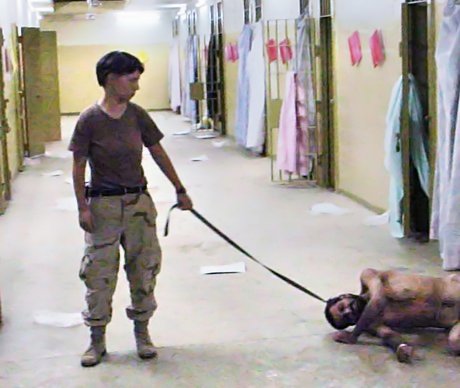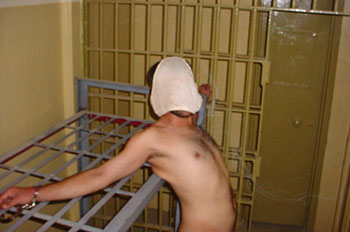It’s been almost eleven years since the release of reports detailing the torture of Iraqis by American soldiers at the Abu Ghraib prison in Iraq. When these photos and reports surfaced in May 2004, most of us would have been finishing the third, fourth, or fifth grades. In some detached way–through now iconic news photographs or fleeting conversation–we might have heard about what happened at Abu Ghraib, or at least have heard its name. But I think it’s unlikely that, especially when we were so young, parents and teachers would have shared the extent of the abuse with us. In fact, I find it understandable, even probable, that they might have actively shielded us from it.
Especially a decade later, however, we might still learn certain lessons—in war, in humanity, in leadership—from what transpired at Abu Ghraib. Most importantly, we might learn that no country, however strong or developed or “progressive” in terms of human rights, is immune to the temptations of wartime. And so I’ve decided to do a two-part blog sequence about Abu Ghraib because to learn these lessons, we must know the details behind them.
For this first post, I wish to discuss what happened at Abu Ghraib somewhat in detail. In my opinion, there is no way for us either to understand what these prisoners went through or to empathize with it. But I think we should make as just an attempt as possible. Therefore, many of those photos and descriptions that follow will be graphic and upsetting.

Abu Ghraib torture victim forced to stand, hooded, on a cardboard box with electrical wires attached to outstretched hands.
Between 2003 and 2004, two reports from the Associated Press and 60 Minutes proffered evidence and photographs accusing US soldiers of the torture and abuse of Iraqi prisoners. Then, on May 10, 2004, Seymour Hersh, an investigative journalist perhaps best known for exposing the cover-up of the My Lai Massacre in 1969, published “Torture at Abu Ghraib” in The New Yorker. He had obtained a fifty-three page confidential report from Major General Antonio M. Taguba that outlined the “institutional failures of the Army . . . [and] numerous instances of ‘sadistic, blatant, and wanton criminal abuses’ at Abu Ghraib.”

Army specialist Lynndie England holds an Iraqi prisoner on a leash.

An Iraqi prisoner handcuffed to a bed nude and with underparts over his face
The report was (and should continue to be) horrifying, to say the least:
Breaking chemical lights and pouring the phosphoric liquid on detainees; pouring cold water on naked detainees; beating detainees with a broom handle and a chair; threatening male detainees with rape; allowing a military police guard to stitch the wound of a detainee who was injured after being slammed against the wall in his cell; sodomizing a detainee with a chemical light and perhaps a broom stick, and using military working dogs to frighten and intimidate detainees with threats of attack, and in one instance actually biting a detainee.
The torture was not only physical abuse of the Iraqi, but also religious and cultural. Islamic law prohibits homosexual activity, Hersh writes, and prisoners routinely were forced to form naked human pyramids and to masturbate in front of each other, as well as the female guards, which is documented in the obtained photographs. (Please see footnote.)
These were only some of the grisly, explicit details Taguba included in the report. Moreover, Taguba suggested that eyewitness accounts and photographic evidence (some of which* I have included above) would support his accusations.

Global reactions to the reports were severe. As can be seen above in the covers from contemporary news sources, many people, both reporters and soldiers, called for Defense Secretary Donald Rumsfeld’ resignation, which eventually was submitted in 2006. Newspapers featured President George W. Bush’s face surrounded by captions such as “Der nächste Krieg?” (“The next Krieg?”), alluding to the World War II Blitzkrieg, which was notable for allying heavily armored and motorized weaponry with air strikes to systematically destroy whole cities. The implications of these associations are grave: the United State is equated with Nazi Germany, and its leader equated with Hitler. And the Jewish Holocaust is not far behind in terms of association.
Though it has only grazed the surface, I think the material I’ve posted is already enough to handle and to stomach for one week. Next week, I wish to discuss the failures in bureaucratic leadership that facilitated the atrocities at Abu Ghraib.
But before I conclude, I wish to note briefly why I have spent an entire posts discussing the tortures at Abu Ghraib, and why I have included these images and descriptions. Certainly, the post might have been submitted less graphically. (Although again, this is only a surface analysis.)
First, I think we owe it to the victims not to mute their sufferings.
But second, in an op-ed in the New York Times from December of last year, Eric Fair, a current creative writing teacher at Lehigh University in Pennsylvania and a former interrogator and torturer at Abu Ghraib, writes:
In some future college classroom, a professor will require her students to read about the things this country did in the early years of the 21st century. She’ll assign portions of the Senate torture report. There will be blank stares and apathetic yawns. There will be essays and writing assignments. The students will come to know that this country isn’t always something to be proud of.
I desperately wish for this to be true, but what is unsettling for me is that I’m not sure if it will prove to be so. A country’s selective memory can be dangerous, and look how our history books stifle the genocide of Native American Indians by manifest-destiny colonists. And this is not unique to the United States. In order to promote nationalism, an understandable tendency of any government is to all but efface the darker parts of its history. But in doing so, we only make ourselves more susceptible to the temptations which might cause us to commit them again. (Just look at the torture report from last year.) No matter how painful it might be, Abu Ghraib might serve as a prescient warning of the possibilities—and in some cases, such as the North Korean prison camps, the very realities—of the atrocities that might happen, whether in times of war or times of autocratic regimes. Hopefully, the memory of it will also prevent these atrocities in the future.
*A note about these photographs: I have chosen to include some of these released photographs because I believe their omission greatly reduces our understanding of Abu Ghraib. That said, I have chosen some of the least graphic, for obvious reasons. Other photographs, for example, document US soldiers giving an invigorated thumbs-up near the penis of a hooded Iraqi man forced to masturbate.
**The first three photographs come from the Wikipedia page, and the latter are readily available on Google Images. If you search “Abu Ghraib” on either of these outlets, please be aware that the visual results are inextricably linked to the photographic documentation of torture and are much more graphic than this post.

Follow Us!